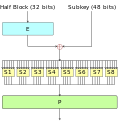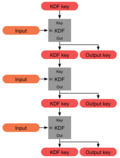cipher key called a round key. A key schedule is an algorithm that calculates all the round keys from the key. Some ciphers have simple key schedules. For...
3 KB (402 words) - 17:31, 15 March 2023
The Advanced Encryption Standard uses a key schedule to expand a short key into a number of separate round keys. The three AES variants have a different...
6 KB (966 words) - 16:28, 6 February 2024
RC4 (redirect from Key-scheduling algorithm)
permutation is initialized with a variable-length key, typically between 40 and 2048 bits, using the key-scheduling algorithm (KSA). Once this has been completed...
44 KB (5,058 words) - 04:47, 31 July 2024
Symmetric-key algorithms are algorithms for cryptography that use the same cryptographic keys for both the encryption of plaintext and the decryption...
15 KB (1,544 words) - 02:53, 7 June 2024
security of IDEA in practice. The very simple key schedule makes IDEA subject to a class of weak keys; some keys containing a large number of 0 bits produce...
12 KB (1,499 words) - 19:07, 14 April 2024
Blowfish (cipher) (redirect from Blowfish key)
of the design include key-dependent S-boxes and a highly complex key schedule. Blowfish has a 64-bit block size and a variable key length from 32 bits up...
17 KB (1,895 words) - 19:43, 14 August 2024
Serpent (cipher) (section Key Schedule)
32-n) uint32_t key[8]; // key provided by user uint32_t subkey[33][4]; // roundkeys const uint8_t S[8][16] = {}; // S-boxes /* key schedule: get prekeys...
16 KB (1,912 words) - 12:54, 8 June 2024
Advanced Encryption Standard (redirect from AES Key)
KeyExpansion – round keys are derived from the cipher key using the AES key schedule. AES requires a separate 128-bit round key block for each round plus...
49 KB (5,595 words) - 13:33, 7 August 2024
to: A hard-coded parameter in a key schedule A key in OpenPGP that is bound by a master key Key (disambiguation) Key (cryptography) This disambiguation...
212 bytes (58 words) - 05:42, 30 December 2019
LEA (cipher) (section Key schedule)
X_{0}[0]\|X_{0}[1]\|X_{0}[2]\|X_{0}[3]} The key schedule of LEA supports 128, 192, and 256-bit keys and outputs 192-bit round keys K i {\displaystyle K_{i}} ( 0 ≤...
19 KB (2,868 words) - 14:58, 26 January 2024
Cryptography (section Symmetric-key cryptography)
a "public key" to encrypt a message and a related "private key" to decrypt it. The advantage of asymmetric systems is that the public key can be freely...
98 KB (10,713 words) - 07:57, 17 August 2024
function Key distribution center Key escrow Key exchange Key generation Key management Key schedule Key server Key signature (cryptography) Key signing...
12 KB (1,496 words) - 00:10, 31 May 2024
same encryption function, but differ in the number of rounds and the key schedule. More recent versions — SAFER+ and SAFER++ — were submitted as candidates...
7 KB (838 words) - 06:46, 27 April 2022
Data Encryption Standard (section Key schedule)
Figure 3 illustrates the key schedule for encryption—the algorithm which generates the subkeys. Initially, 56 bits of the key are selected from the initial...
59 KB (6,541 words) - 09:32, 30 July 2024
128-bit key. It has a Feistel structure with a suggested 64 rounds, typically implemented in pairs termed cycles. It has an extremely simple key schedule, mixing...
13 KB (1,189 words) - 18:51, 14 April 2024
For example, in applications where the key is used for a cipher, the key schedule in the cipher may be modified so that it takes a specific length of time...
14 KB (1,817 words) - 16:14, 17 July 2024
Brute-force attack (redirect from Exhaustive key search)
attempt to guess the key which is typically created from the password using a key derivation function. This is known as an exhaustive key search. This approach...
21 KB (2,250 words) - 15:26, 19 July 2024
Key generation The key generation algorithm selects a random integer x {\displaystyle x} such as 0 < x < r {\displaystyle 0<x<r} . The private key is...
8 KB (823 words) - 08:44, 16 August 2024
employ a cipher designed to prevent related-key attacks altogether, usually by incorporating a strong key schedule. A newer version of Wi-Fi Protected Access...
5 KB (688 words) - 07:27, 20 November 2023
A public key infrastructure (PKI) is a set of roles, policies, hardware, software and procedures needed to create, manage, distribute, use, store and...
34 KB (4,098 words) - 09:19, 10 July 2024
transaction schedule, a list of actions from a set of transactions in databases Interval scheduling Key schedule, cryptographic method and setup of code key Instrument...
2 KB (257 words) - 22:00, 22 December 2023
cryptography, a key derivation function (KDF) is a cryptographic algorithm that derives one or more secret keys from a secret value such as a master key, a password...
13 KB (1,645 words) - 14:47, 4 August 2024
pre-computed key-dependent S-boxes, and a relatively complex key schedule. One half of an n-bit key is used as the actual encryption key and the other...
9 KB (841 words) - 21:49, 2 August 2024
similar, even identical in some cases, requiring only a reversal of the key schedule. Therefore, the size of the code or circuitry required to implement such...
10 KB (1,316 words) - 05:28, 15 May 2024
KASUMI (section Key schedule)
uses a round key which consists of eight 16-bit sub keys derived from the original 128-bit key using a fixed key schedule. The 128-bit key K is divided...
17 KB (2,555 words) - 01:42, 17 October 2023
(DH) key exchange is a mathematical method of securely exchanging cryptographic keys over a public channel and was one of the first public-key protocols...
47 KB (5,161 words) - 09:41, 11 August 2024
key (PSK) is a shared secret which was previously shared between the two parties using some secure channel before it needs to be used. To build a key...
3 KB (410 words) - 18:43, 18 July 2024
In cryptography, key size or key length refers to the number of bits in a key used by a cryptographic algorithm (such as a cipher). Key length defines the...
29 KB (3,213 words) - 18:51, 7 June 2024
in contrast to key scheduling, which typically refers to the internal handling of keys within the operation of a cipher. Successful key management is critical...
34 KB (3,519 words) - 22:07, 14 July 2024
Bcrypt (category Key derivation functions)
developed a new key setup algorithm for Blowfish, dubbing the resulting cipher "Eksblowfish" ("expensive key schedule Blowfish"). The key setup begins with...
26 KB (2,753 words) - 04:19, 2 July 2024














